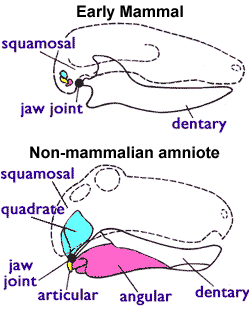Articular bone
Articular bone refers to any bone that participates in a joint (articulation), where two or more bones meet and move on one another. These bones are critical components of the skeletal system, playing a key role in facilitating movement and supporting the body's structure. Articular bones can be found in all types of synovial joints, including hinge joints, such as the elbow and knee; ball and socket joints, like the hip and shoulder; and saddle joints, exemplified by the thumb joint.
Structure[edit | edit source]
Articular bones are characterized by their smooth, cartilage-covered surfaces at the ends, known as articular cartilage. This cartilage is crucial for reducing friction and absorbing shock at the joint surfaces, allowing for smooth and pain-free movement. Underneath the articular cartilage, the bone is typically denser and stronger than in other areas, providing stability and support to the joint.
Function[edit | edit source]
The primary function of articular bones is to facilitate movement by forming joints with other bones. The specific type of movement depends on the joint's structure and the articular bones involved. For example, the femur and the pelvis form a ball and socket joint, allowing for a wide range of movement in multiple directions. In contrast, the articulation between the phalanges in the fingers is a hinge joint, permitting movement primarily in one plane.
Types of Articular Bones[edit | edit source]
Articular bones can be classified based on the type of joint they form:
- Hinge Joints: Include bones like the humerus and the ulna at the elbow.
- Ball and Socket Joints: Comprise bones such as the femur and the acetabulum of the pelvis.
- Saddle Joints: Involve bones like the trapezium in the wrist and the first metacarpal bone of the thumb.
- Pivot Joints: Include the atlas and axis bones in the neck, allowing for rotation.
- Gliding Joints: Consist of the articulations between the tarsal bones in the foot and the carpal bones in the wrist.
Clinical Significance[edit | edit source]
Articular bones are susceptible to various conditions that can impair their function, including arthritis, osteoporosis, and fractures. Arthritis, a common condition affecting the joints, can lead to the degeneration of articular cartilage, causing pain and reduced mobility. Osteoporosis weakens the bone, making it more prone to fractures, particularly in the hip, wrist, and spine. Prompt diagnosis and treatment of these conditions are essential for maintaining joint health and function.
See Also[edit | edit source]
Search WikiMD
Ad.Tired of being Overweight? Try W8MD's physician weight loss program.
Semaglutide (Ozempic / Wegovy and Tirzepatide (Mounjaro / Zepbound) available.
Advertise on WikiMD
|
WikiMD's Wellness Encyclopedia |
| Let Food Be Thy Medicine Medicine Thy Food - Hippocrates |
Translate this page: - East Asian
中文,
日本,
한국어,
South Asian
हिन्दी,
தமிழ்,
తెలుగు,
Urdu,
ಕನ್ನಡ,
Southeast Asian
Indonesian,
Vietnamese,
Thai,
မြန်မာဘာသာ,
বাংলা
European
español,
Deutsch,
français,
Greek,
português do Brasil,
polski,
română,
русский,
Nederlands,
norsk,
svenska,
suomi,
Italian
Middle Eastern & African
عربى,
Turkish,
Persian,
Hebrew,
Afrikaans,
isiZulu,
Kiswahili,
Other
Bulgarian,
Hungarian,
Czech,
Swedish,
മലയാളം,
मराठी,
ਪੰਜਾਬੀ,
ગુજરાતી,
Portuguese,
Ukrainian
Medical Disclaimer: WikiMD is not a substitute for professional medical advice. The information on WikiMD is provided as an information resource only, may be incorrect, outdated or misleading, and is not to be used or relied on for any diagnostic or treatment purposes. Please consult your health care provider before making any healthcare decisions or for guidance about a specific medical condition. WikiMD expressly disclaims responsibility, and shall have no liability, for any damages, loss, injury, or liability whatsoever suffered as a result of your reliance on the information contained in this site. By visiting this site you agree to the foregoing terms and conditions, which may from time to time be changed or supplemented by WikiMD. If you do not agree to the foregoing terms and conditions, you should not enter or use this site. See full disclaimer.
Credits:Most images are courtesy of Wikimedia commons, and templates, categories Wikipedia, licensed under CC BY SA or similar.
Contributors: Prab R. Tumpati, MD

